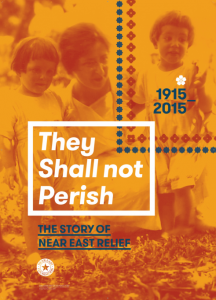 1st Showing : One Day Only–in West Hartford
1st Showing : One Day Only–in West Hartford
Date: Thursday, April 28, 2016
Also join us for Genocide Recognition or Quest for Justice Lecture w. Harut Sassounian at at 5:30PM
Location: UConn School of Social Work, Zachs Community Room, 1798 Asylum Avenue, West Hartford, CT. Get directions.
2nd Showing: 5 months in Storrs, CT
Date: Friday, April 30, 2016 – Friday, September, 30, 2016
Location: UConn Storrs Campus, Laurel Hall Lobby.
This Exhibit has been provided by the Near East Foundation.
ABOUT NEAR EAST RELIEF – CONNECTICUT:
A total of 69 volunteers from Connecticut served on Near East Relief’s Connecticut State committee from 1915 to 1930. The committee initially operated out of the Strand Theatre Building in Hartford, and later moved to the Connecticut Trust Company Building.
Connecticut boasted one of the highest per capita rates of donation to Near East Relief in the country. The State raised more than $628,000 for Near East Relief from 1915 and 1921; this included an astonishing $44,487 for the 1920 Christmas campaign.
Connecticut’s politicians were also active in Near East Relief. In October 1921, Governor Everett John Lake attended a State conference on Near East Relief in Hartford. The conference included an advance screening of Near East Relief’s film, Alice in Hungerland, which told the story of a fictional American child’s visit to real Near East Relief orphanages in Turkey and Armenia. The film went on to become an international sensation.
Former Near East Relief Associate General Secretary Harold C. Jaquith and his wife pooled their resources with a few friends to purchase a bucolic farm in Kent, CT. The group built a few small cabins and converted the property into a retreat for returned relief workers; it was a comfortable place to relax, socialize, and reminisce about experiences in the field.
Prominent Near East Relief Workers From Connecticut
Connecticut produced many heroic Near East Relief workers. These are just a few.
Mr. & Mrs. Lindon S. Crawford, of Hartford, CT, began their careers as missionaries in Trebizond (now Trabzon, Turkey) in 1879. The Crawfords, like many missionaries in Asia Minor, helped to administer relief to Armenian orphans and refugees in the immediate aftermath of the Genocide. Mr. Crawford died in Trebizond in 1918. Mrs. Crawford (née Olive N. Twichell) continued to work at the Near East Relief orphanage in Trebizond. Mrs. Crawford contracted typhus while helping Greek and Armenian refugees from the Turkish interior as they awaited transport to safety. She died in 1923.
Miss Elizabeth Murlless of Hartford, CT, signed with Near East Relief in Constantinople in April 1922. She did orphanage work at Trebizond and Samsoun. When the burning of Smyrna created a state of emergency for all orphans, refugees, and relief workers in Turkey, Miss Murlless helped to evacuate 2,000 orphans from Samsoun to safety in Greece.
Mr. Edward T. Perry of Hartford, CT, traveled to the Near East as a member of the Leviathan party on February 16, 1919 – this was the first large group of Near East Relief workers to enter the region after the end of World War I. Mr. Perry was sent to the Caucasus region, where he oversaw the health and wellness of 850 orphans. He was placed in charge of industrial work in Erivan where, unfortunately, he contracted typhus. He returned to the States in May 1920 and took a job in the personnel department of the Near East Relief. He soon enrolled at the Theological Seminary of Hartford with the intention of returning to the Near East as a missionary.
Christopher C. Thurber of Norwich, CT, sailed to Constantinople (now Istanbul) at the start of World War I. He worked with typhus-stricken Near East Relief orphans. Thurber himself contracted typhus, but he recovered in time to direct the safe transfer of 7,000 children from Sivas, Turkey, to Greece after the Smyrna Disaster – a massive fire that destroyed the Armenian and Greek quarters of that city in September 1922. Thurber also earned respect for his attempt to save a refugee woman from being beaten by soldiers in Scutari, Turkey. Thurber was flogged as punishment for the attempted rescue. He sustained permanent damage to his feet and walked with a cane for the rest of his life.
In 1924, Thurber traveled to Greece to become director of Near East Relief’s work in the region. There, he supervised the education of children in orphanages and also established homes in Athens for orphanage graduates. Thurber was in the midst of planning a new tuberculosis pavilion for children when he suffered a stroke and died on May 31, 1930. His contribution to public education and health was so pervasive that the Greek government held a state funeral and declared a national day of mourning in his honor.
“Words are insufficient to praise adequately [Near East Relief’s] good Samaritanism. Many Hartford contributors shared in it and must find deep satisfaction and gratitude in the inspiring story of humanitarian effort the success of the Near East Relief has revealed.”
— The Hartford Times, July 9, 1929
Learn more about Near East Relief at the Digital Museum!